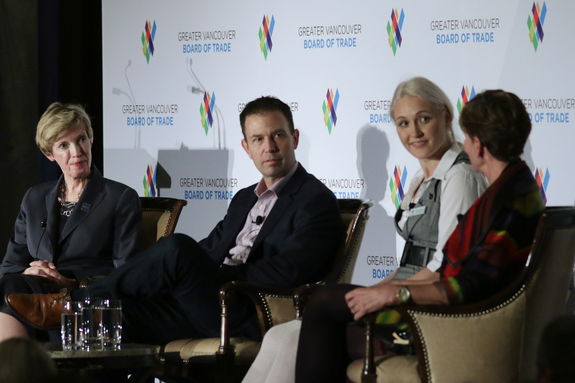This story first appeared in The Vancouver Sun, February 11, 2017 with credit to Michael Bernard– Postmedia Content Works.
A group of automotive students are standing in a circle, ready to learn how to dismantle a car engine. But bizarrely, there is no actual car engine in all its greasy glory.
That’s because the car motor is a virtual one, a three-dimensional image transmitted into each of the student’s Virtual Reality headsets. Through the lenses and under an instructor’s guidance, they will see how the engine is disassembled and then put back together again before they are asked to do it themselves.
It’s a scene that BCIT President Kathy Kinloch enthusiastically uses to explain just how disruptive technology has profoundly changed how we teach people.
It was just one of a number of issues she raised during her speech and a BCIT-led panel discussion on disruptive technology at the Greater Vancouver Board of Trade earlier this week. A sampling of her points includes the following:
- Disruptive technologies such as virtual reality, automation and connectivity are transforming our world.
- Those changes have prompted predictions that 50 per cent of today’s Fortune 500 companies will no longer exist in a decade.
- Business consultancy McKinsey estimates half of the activities people are paid to do today could be automated, representing $15 trillion lost in global wages.
- Millenials can expect to change careers six to seven times during their working life—often in areas that don’t even exist today.
While some have predicted mass unemployment, Kinloch sees a brighter future, particularly if educational institutions like BCIT rise to the challenge. “People will find new, higher-skilled employment if we provide accessible and practical retraining that is aligned with current and emerging industry needs,” she told the business audience.
Disruptive technology is triggering massive changes in the way BCIT is educating more than 48,000 full and part-time students annually, including abandoning the old “chalk and talk” teaching ways, she said in a later interview.
“The traditional teaching model for many of us was a teacher at the front of the room. We received the information (from this authority) and somehow fed it back so that there was some kind of attempt to assess our learning.”
That model is almost entirely gone now, replaced by methods—including the use of virtual reality—that are proving far more effective for today’s learners, she said.
“Students will always remember [learning experiences like those using virtual reality],” she said. “It is much more effective, much more engaging, and I think it leads to greater success because critical thinking and analysis is immediately integrated into subject matter learning.”
Kinloch stressed that the impetus for change has often come through BCIT’s long history of close connections with industry, connections that are also essential for BCIT to keep up with industry’s changing needs.
“One of our differentiating factors is our hands-on delivery, and coupling that with the industry exposure and working with industry, it’s a hallmark for applied institutions like BCIT.”
Close contacts with industry is one reason why BCIT has a record of 96 per cent of its degree graduates finding jobs, she said. But it also compels the institution to constantly work with its industry partners to make sure BCIT is meeting their needs in the workplace in a rapidly evolving technological world.
“I think post-secondary education is challenged to keep up with what industry sees because industry sees the trends coming earlier,” she said. “So we’re connected closely with each key industry sector, through our faculty and industry partnerships. We are listening to them to determine the trendline so we can adapt our programs to meet industry needs. That is why I see partnerships as such a key component for us moving forward.’’
Kinloch also pointed out that BCIT’s impact on the provincial economy is considerable: it contributes $750 million a year and generates 10,000 direct and indirect jobs. Also, it is reaching out globally with active partnerships with post-secondary institutions in China, India, and many European Union companies in a bid to explore international opportunities.
Jeff Booth, one of the BCIT panelists, said what impressed him most about the session was a story by fellow panelist Nadia Dobrianskia about change. She went into her BCIT class (on computer technology) and they told her, “We are not offering that course anymore because it is not relevant anymore,” he said.
“For an organization to be that fast in saying (the existing course) won’t be relevant anymore, we have something better: that’s impressive. People are holding onto the existing infrastructures too long, holding out against radical change.”
Booth has made a business of disrupting the status quo. Drawing on his background as a builder, Jeff co-founded BuildDirect in 1999, which took on the inefficiencies and high costs inherent with the home improvement and building supplies industry.
The danger for many companies—and most institutions in our society–is that they ignore the signs that their business is becoming obsolete, he said, sharing the example of a now defunct video store chain.
“If you look back at the curve for Blockbuster, there were a few less people in the store but they were still building stores until the moment the chain collapsed. This is our government, these are our political institutions, this is our education and our health care, everything is facing radical change.”

Embracing change successfully — one company’s story
Disruptive technological change can wreak havoc, wiping out jobs held by lower-skilled, middle-aged workers and consigning former giants of industry to history’s dustbin, an audience was told at a recent panel discussion led by the BC Institute of Technology.
At the same time, disruptive change can also empower people and dramatically improve the quality of their lives. Just ask Sue Paish, who moderated the panel at a Greater Vancouver Board of Trade luncheon last week.
As president and CEO of Lifelabs, Canada’s largest community laboratory, Paish says the medical diagnostics business, like most businesses, is subject to technological change.
“Of course, we are faced with the opportunities to either embrace or ignore that tech change, and we do the latter at our peril,” she said in a later interview. Lifelabs decided to grasp the opportunities, using the tremendous advances in data collection and analysis that didn’t exist a decade ago, to deliver an important benefit online to more than 1.2 million patients across Canada. And those numbers are growing by several thousand each and every week.
Today, more than 750,000 patients in British Columbia and another 460,000 in Ontario are now able to view their lab results online—for everything from blood glucose tests for diabetics to cholesterol readings for heart patients—through the company’s My Ehealth program in as little as a few hours after the tests are done.
Paish said her company—with more than 5,400 employees who process more than 100 million lab tests annually—could have entered the debate about whether or not patients had the right to this information. It could have continued focusing on delivering results faster to physicians or looked for ways to better alert patients that the test results were now available.
Instead, it considered that its vision of “building a better Canada” was better served by working on delivering lab results directly to patients.
“It is actually their information, not our information, not the government’s information,” she said, adding that 70 per cent of health care is about diagnostics. “It belongs to the patient. Give them the information so that they can start to make decisions with their physicians about how to preserve their health.”
Paish says embracing technological change takes a certain mindset, one that is pro-active rather than reactive, where you don’t simply continue doing things as you have in the past.
Lifelabs has benefited from employing BCIT grads that work in 30 different areas of its business and demonstrate tremendous technical skills, and, just as importantly, a pro-active mindset that says “Let’s look at solving this problem differently,” she said.
“It’s that mindset of being proactive that is the reason we feel so aligned with BCIT. And it’s that kind of mindset that allow us to do things like the My Ehealth program.”
Betting on education — one student’s story
Sometimes the need to change strikes like a lightning bolt out of the blue, and sometimes it arrives as a pink slip, ending your job.
Or, if you are Nadia Dobrianskia, the realization that you need to change may dawn over a period of years, allowing you time to “school up” and make the leap to another field.
“I was a UBC graduate in biochemistry in 2008, and I worked in industry for a number of years,” she said on Tuesday while participating in a BC Institute of Technology-led panel discussion on disruptive technological change.
As Nadia worked in a Vancouver lab on ways to extract chemicals from wood, such as pine-beetle ravaged samples, she noticed she was spending an inordinate amount of time compiling results from testing, time she believed would be far better spent analyzing what the data actually meant.
“I was noticing that there was a big push towards (computer) technology but I did not have any experience in it previously. I thought about it and realized that going to school to learn about it would be beneficial for me.”
Scouting around schools a few years later, she found that the full-time Computer Systems Technology program at BCIT best suited her needs for developing skills in data analysis rather than data assembly. In 2012, she gave her employer six months’ notice and jumped into studying computer technology.
“It wasn’t easy, especially giving up a regular full-time salary and taking out student loans to bridge the gap,” she said. Two years later, she graduated from the BCIT program and within one month had a job in a new career—as a computer scientist at Vancouver-based Simba Technologies—at a higher salary than her previous career.
“In retrospect, I am extremely happy that I pushed myself past a little bit of the fear and re-trained in a completely different field,” she said. “In the end I had a huge payoff. “
Her advice to others contemplating a change like hers?
“I’m not going to say it is easier, but it is much more rewarding to grow with that change and to adapt to it rather than try to resist it.”
